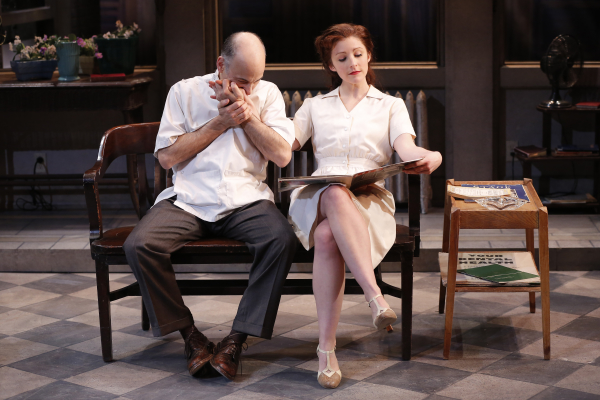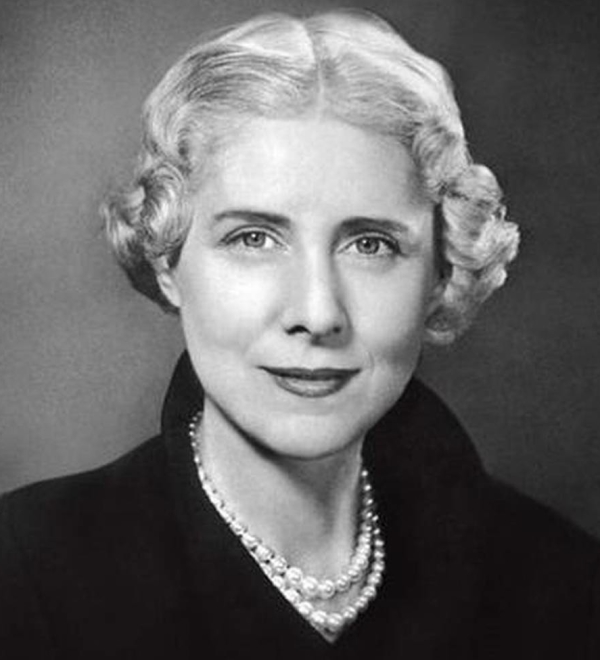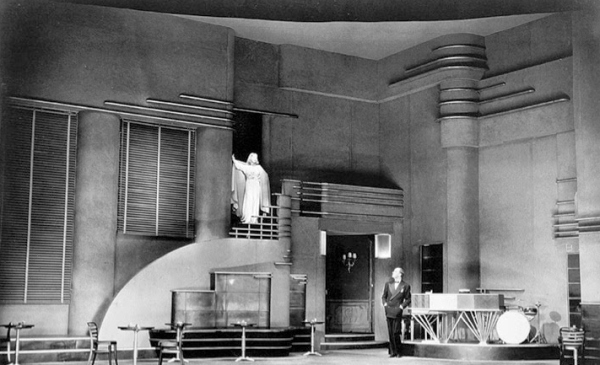An Outspoken Critic Provokes Visions of Stages Past and Present (Part II)
This is part II of Michael Feingold's latest "Thinking About Theater" column.
Click here to read part I.

(© Carol Rosegg)
In 1937, London's Sunday Times sent its pontifical, notoriously captious theater critic, James Agate (1877-1947), to New York, to scrutinize the American theater firsthand. By that time, Agate, like London, had long been familiar with American plays and actors; work had flowed freely between the two countries. In the 1890s and 1900s, American stars like John Drew, Ada Rehan, Nat Goodwin, and the playwright-actor William Gillette had been popular in both. In the 1920s, as the heyday of European operetta gave way to an era dominated by American popular song, figures like the Astaires and Sophie Tucker became beloved across the Atlantic, as did the emerging generation of American playwrights headed by Eugene O'Neill.
Agate came to America with trepidation, confiding his qualms in Ego 3, the volume of his autobiographical diary-cum-scrapbook that covers 1937, the year of his journey. "I have always found Americans enchanting," he notes on shipboard, "while rather boggling at their country. This is because it frightens me; I am afraid of its slang, efficiency, bustle, and stark cruelty."
After landing, he would partially modify his views on all these counts. While upper- and lower-class New Yorkers continued to enchant him, his observation of grumpy box-office treasurers and other mid-level types convinced him that "the only un-charming people in this country are the in-betweens." Wall Street's easygoing manners made him think that America's "bustle" was "all ballyhoo, carefully fostered for consumption abroad." While marveling at New York skyscrapers (which made London look like "a collection of native huts"), especially the still-new Rockefeller Center, he thought New Yorkers in general dressed dowdily compared to Europeans, and complained, except at the best restaurants, that the food lacked flavor.

Among critical colleagues and theater artists in New York, Agate was disconcerted to be perceived as not an outsider but a dissenter. "The contemptible is the contemptible all the world over," he wrote, but "I find myself at variance with New York opinion about its good things." One was Clare Boothe Luce's hit comedy, The Women, which he thought the local reviewers had underrated as merely amusing. Taken by the play's malicious wit, Agate was even more captivated by its skillful performance. "The playing of these American companies is superb, and I doubt very much whether we [in London] could match this one individually or collectively…we hardly have the actresses, and certainly we haven't the team."
Agate's taste did match New York's on some key exhibits: He echoed his local colleagues' raptures over Helen Hayes in Victoria Regina (then still unseen in London because of British censors' rule against depicting the royals onstage). Agate joined the locals, too, in his delight over Rodgers and Hart's Babes in Arms, writing, as he sailed home, that "it has danced its way through everything I have seen and given this hard-boiled city a dreamlike quality."
Yet the disagreements remained sharp. He was shocked to find New York critics rating Maurice Evans, then playing Richard II on Broadway, a greater actor than Gielgud. He found only mild laughs in the year's biggest hit, You Can't Take It With You. And he diverged deeply from the local scribes over Maxwell Anderson's High Tor, that year's Drama Critics' Circle Award winner. Agate called it "high fudge," though acknowledging the brilliance of its young leading man, Burgess Meredith.
Agate took far greater exception, though, to the critics' dismissive attitude toward the show that excited him most in New York: The Federal Theatre's "Living Newspaper" docudrama, Power, by Arthur Arent. This statistic-laden, multimedia examination of the cost of public versus private ownership of utilities left Agate "entranced," he said, despite his being "totally indifferent to the price of electric light in New York or anywhere." The acting was "far and away the best [I] have seen in this country." He spends some five pages of Ego 3 on the origin and growth of the WPA's arts subsidies, including the Federal Theatre, calling it "the most important thing I have struck in this country." The critics, he complained, "have said little about it," leaving him "to stumble across it" by himself.

Agate's enthusiasm for subsidized, populist, inexpensive theater is all the more remarkable because it shows him reaching, for art's sake, all the way across the political spectrum. He himself was innately conservative, to some degree even reactionary. Power, he clearly saw, was socialist "propaganda, pure and unalloyed." But to let his politics prevent him from rejoicing at the artistic vitality of a new work, and the potential importance of a new movement, would have gone against his critical principles. England at the time had no state-subsidized theater, and here we were growing a gigantic one. Theirs took another 25 years to come into being; ours quickly withered and died, a prey to political contentions and commercial rivalries. Multiple morals can be drawn from this little footnote to theater history. (When Hallie Flanagan proudly told HUAC that the WPA had produced plays by Shakespeare and Marlowe, they asked her if Marlowe was a Communist. One would like to have heard Agate's reaction to that.)
Agate's American experience shook him up. A year after his return, he irritated some of his readers by announcing that the three best plays to be seen in London were all American — Robert Sherwood's Idiot's Delight, S.N. Behrman's adaptation of Giraudoux's Amphitryon 38 with the Lunts, and the Group Theatre's production of Golden Boy.
Here, as always, he saw quite clearly the works' limitations. A "distinguished British playwright" (unidentified) wrote him, protesting that in Odets' play, "Practically every scene has been jazzed up, given more punch and excitement and noise than it should have, and without reference to realty at all." In reply, Agate didn't deny the accusation, describing Golden Boy as "a highly meretricious piece of theatrical impudence that happens to hold an audience pin-still" — the latter clause being his point. When, a few months later, a young British troupe essayed Odets' Paradise Lost, Agate was even readier. His review ripped the play to shreds, improbability by improbability — and then turned around to declare Odets "a born dramatist" and the piece "better worth seeing than all London's commercial successes" because, even when nonsensical, "it is brainy nonsense about things worth thinking about." And, most importantly, "because [it] doesn't bore me."
There sits one of criticism's central truths, stated by a master. And I smile at it as I leave Agate's books behind and head out to see — what else? — New York's current Peccadillo Theater Company revival of Odets' Rocket to the Moon.
Michael Feingold's next two-part "Thinking About Theater" column will appear on consecutive Fridays March 13 and 20.










